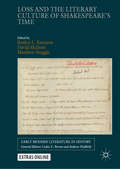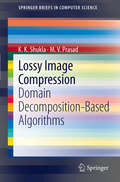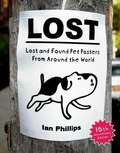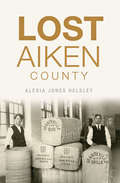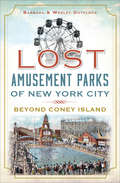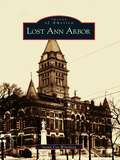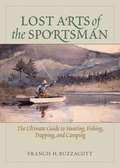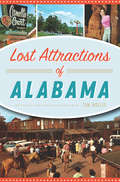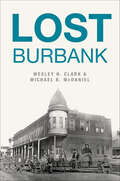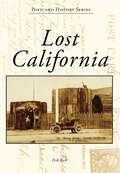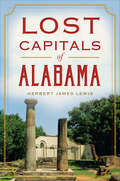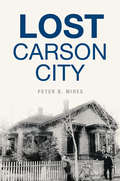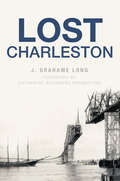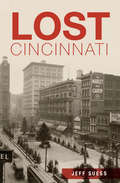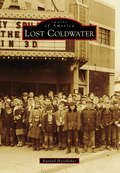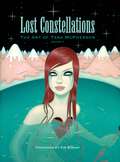- Table View
- List View
Loss and the Literary Culture of Shakespeare’s Time (Early Modern Literature in History)
by Matthew Steggle Roslyn L. Knutson David McInnisAs early modernists with an interest in the literary culture of Shakespeare’s time, we work in a field that contains many significant losses: of texts, of contextual information, of other forms of cultural activity. No account of early modern literary culture is complete without acknowledgment of these lacunae, and although lost drama has become a topic of increasing interest in Shakespeare studies, it is important to recognize that loss is not restricted to play-texts alone. Loss and the Literary Culture of Shakespeare’s Time broadens the scope of the scholarly conversation about loss beyond drama and beyond London. It aims to develop further models and techniques for thinking about lost plays, but also of other kinds of lost early modern works, and even lost persons associated with literary and theatrical circles. Chapters examine textual corruption, oral preservation, quantitative analysis, translation, and experiments in “verbatim theater”, plus much more.
Loss in French Romantic Art, Literature, and Politics (Routledge Research in Art History)
by Jonathan P. RibnerAn interdisciplinary examination of nineteenth-century French art pertaining to religion, exile, and the nation’s demise as a world power, this study concerns the consequences for visual culture of a series of national crises—from the assault on Catholicism and the flight of émigrés during the Revolution of 1789, to the collapse of the Empire and the dashing of hope raised by the Revolution of 1830. The central claim is that imaginative response to these politically charged experiences of loss constitutes a major shaping force in French Romantic art, and that pursuit of this theme in light of parallel developments in literature and political debate reveals a pattern of disenchantment transmuted into cultural capital. Focusing on imagery that spoke to loss through visual and verbal idioms particular to France in the aftermath of the Revolution and Empire, the book illuminates canonical works by major figures such as Eugène Delacroix, Théodore Chassériau, and Camille Corot, as well as long-forgotten images freighted with significance for nineteenth-century viewers. A study in national bereavement—an urgent theme in the present moment—the book provides a new lens through which to view the coincidence of imagination and strife at the heart of French Romanticism. The book will be of interest to scholars working in art history, French literature, French history, French politics, and religious studies.
Lossy Image Compression
by K K Shukla M. V. PrasadImage compression is concerned with minimization of the number of information carrying units used to represent an image. Lossy compression techniques incur some loss of information which is usually imperceptible. In return for accepting this distortion, we obtain much higher compression ratios than is possible with lossless compression. Salient features of this book include: four new image compression algorithms and implementation of these algorithms; detailed discussion of fuzzy geometry measures and their application in image compression algorithms; new domain decomposition based algorithms using image quality measures and study of various quality measures for gray scale image compression; compression algorithms for different parallel architectures and evaluation of time complexity for encoding on all architectures; parallel implementation of image compression algorithms on a cluster in Parallel Virtual Machine (PVM) environment.
Lost
by Ian PhillipsDespite all the visual distractions of the digital age, one low-tech form of mass communication remains as popular as ever: the lost pet poster. Stapled to telephone poles and bulletin boards in cities and suburbs worldwide, these often hastily made signs are quirky combinations of hand-drawn illustration, emotional longing, and surprisingly offbeat humor. For more than a decade, artist and animal lover Ian Phillips collected lost and found pet posters from around the world.LOST features the most notable selections from Phillips's collection chosen for their cleverness, humor, sorrow, entreaties, rewards, and--in several instances--sheer outlandishness. Featuring a veritable Noah's ark of animals--from everyday pets such as dog, cats, hamsters, and turtles to more unusual companions, including ferrets, parrots, cows, and cockatiels--these remarkable posters are their own form of folk art. Telling tales of friendship, loss, and hope, they are a powerful testament to the love and devotion shared by pet owners everywhere.
Lost Aiken County (Lost)
by Alexia Jones HelsleyFrom a home to the fierce Westo tribe to a hub of the equestrian industry, Aiken County has had a huge influence on South Carolina. And some of the structures that mark that history have disappeared. More than two hundred years ago, the Horse Creek Chickasaw Squirrel King held court near North Augusta. The first locomotive built for public transportation, the "Best Friend" from Charleston to Hamburg, first ran in the area. The home of noted businessman Richard Flint Howe hosted both the Duke and Duchess of Windsor and students of the University of South Carolina Aiken. William Gregg and the Graniteville Mill helped shape the textile industry in the state. Author Alexia Jones Helsley details the lost history of Aiken County.
Lost Amusement Parks of New York City: Beyond Coney Island (Lost Ser.)
by Wesley Gottlock Barbara GottlockA historical tour of fun and frolic in the five boroughs—including photos from the good old days. Coney Island is an iconic symbol of turn-of-the-century New York—but many other amusement parks have thrilled the residents of the five boroughs. Strategically placed at the end of trolley lines, railways, public beaches, and waterways, these playgrounds for the rich and poor alike first appeared in 1767. From humble beginnings, they developed into huge sites like Fort George, Manhattan&’s massive amusement complex. Each park was influenced by the culture and eclectic tastes of its owners and patrons—from the wooden coasters at Staten Island&’s Midland Beach to beer gardens on Queens&’ North Beach and fireworks blasting from the Bronx&’s Starlight Park. As real estate became more valuable, these parks disappeared. With this historical tour, you can rediscover the thrills of the past from the lost amusement parks of New York City.
Lost Amusement Parks of the North Jersey Shore (Images of America)
by George Severini Rick GeffkenThe Jersey Shore has always attracted people seeking relief from summer heat and humidity. Long before Europeans came here, the native Lenape clammed, fished, and played games on the beach and in the surf. These original people could scarcely have imagined that, by the end of the 19th century, the 120-mile-long coastline of New Jersey would be dotted with amusement parks featuring gentle kiddie car rides, terrifying roller coasters, merry-go-rounds, and fast-food emporiums. James Bradley in Asbury Park and William Sandlass Jr. in Highland Beach created mass entertainment for hundreds of thousands of people. Their seaside recreation centers, along with those in Long Branch, Bradley Beach, Pleasure Bay, and others, endured for years but are just fond and fading memories today.
Lost Ann Arbor
by Susan Cee WinebergAnn Arbor might have become just another small Michigan village had it not been for one crucial event: its designation as the home of the University of Michigan in 1837. Its subsequent development into a thriving cultural and intellectual community was marked by its extraordinary architecture, from the grand 1878 courthouse to the exquisite original university buildings and fashionable East Huron Street. The expansion of the town and university, the arrival of the automobile, and frequent fires began atransformation of Ann Arbor that led to the tragic demolition of some of its most remarkable structures. Lost Ann Arbor is a tribute to these long-lost treasures and the 19th century way of life that accompanied them.
Lost Arts of the Sportsman: The Ultimate Guide to Hunting, Fishing, Trapping, and Camping
by Francis Henry BuzzacottThe Lost Art of the Sportsman is an exhaustive reference text and a compulsively addictive narrative from the turn of the 1900s.Francis H. Buzzacott would find little in common with the hiker and camper of contemporary times. This is the American frontiersman at his best—no-holds-barred approach to sporting. And while some of the advice and information in The Lost Art of the Sportsman has undoubtedly been replaced with the advent of new technology, what’s surprising is just how much of the book is still essential advice and knowledge for the modern hunter, fisher, and camper.Inside, you’ll learn: What to bring on a fishing, hunting, or camping trip Recipes for easy campfire meals Hunting, fishing, and trapping tips for a variety of animals How to deal with an emergency in a remote place Clothing choices for a variety of situations Tips and secrets for all varieties of firearmsFaithfully reproduced exactly how it was originally printed, The Lost Art of the Sportsman comes complete with hundreds of original pieces of line drawings and artwork, a true collector’s edition for hunters, fisherman, and campers alike.
Lost Attractions of Alabama
by Tim HollisAlabama has had an enviable success rate when it comes to tourist attractions, with some that date back to the 1930s still drawing crowds today. But many others have come and gone, sometimes leaving little evidence of their existence. Join Alabama native Tim Hollis as he revisits iconic attractions such as Canyon Land Park and Sequoyah Caverns, the floral clock at Birmingham's Botanical Gardens and the traffic safety torch held aloft by Vulcan, the iron man. Many Gulf Coast attractions are gone, including Styx River Water World and Spooky Golf, but the memories remain.
Lost Bay City
by Ron BloomfieldWhen the phrase "Do you remember?" is uttered in Bay City, it is usually followed by the name of a hotel, restaurant, business, or building. Slowly, many parts of local history have been lost to the sands of time. Fire took many, followed by condemnations and the inevitable advance of progress. An empty lot may be all that remains of a once-prominent structure, but sometimes a new landmark emerges. In the case of one famous address at Center and Water Streets, the Wenonah Hotel rose out of the ashes of the Fraser House, another prominent facade. Seven decades later, the Wenonah, too, succumbed to fire; out of those ashes rose the Delta College Planetarium, a third-generation landmark. Photographs help residents remember, though each person who experienced something firsthand has his or her own distinct connection with these pieces of lost Bay City.
Lost Burbank (Lost)
by Wesley H. Clark Michael B. McDanielSlowly fading with the city's ever-changing landscape, the places and people of Burbank's past tell a vibrant story. Before the arrival of Warner Bros. and Walt Disney, First National Pictures built its original studio lot on Olive Avenue in 1926. For over sixty years, Lockheed Aircraft Company produced some of the nation's best airplanes where the massive Empire Shopping Center now stands. Heavyweight champion James Jeffries turned his Burbank ranch home and barn into a beloved landmark and boxing venue. And inventor Joseph Wesley Fawkes's scheme to build a monorail to Los Angeles became a local laughingstock. Die-hard Burbankers Wes Clark and Michael McDaniel collect these and many more forgotten local stories where they can finally be found.
Lost California (Postcard History Series)
by Mr. Erik BeckThe postcards in this collection reflect a hidden past of California that exists now only on the page. From college gates at Stanford destroyed by the 1906 earthquake and hotels in Catalina, Santa Barbara, and Oakland ravaged by fire to giant redwoods on the coast felled by storms and much of downtown Los Angeles razed in the name of the progress, California's landscape has changed dramatically in the last 125 years. The buildings demolished in San Diego's Balboa Park after the 1915 exposition closed are shown here as is downtown San Francisco before the earthquake and fire of 1906, amusement parks that decorated waterfronts from Long Beach to Santa Monica, and city halls from Anaheim to San Jose.
Lost Capitals of Alabama (Lost)
by Herbert James LewisAlabama's capital has roots all over the state. It first emerged in St. Stephens in 1799, a small fort acquired from the Spanish atop a tall limestone bluff overlooking the Tombigbee River. Next came Huntsville in the Tennessee Valley, where the state constitution emerged. Cahawba was the capital to receive a visit from the Marquis de Lafayette, the last surviving general of the American Revolution. In 1826, Tuscaloosa took the reins for twenty years before the final move to Montgomery. Discover the leaders and events that established the state and the fates of each dynamic governmental center as author Jim Lewis traces the history of Alabama's lost capitals.
Lost Carson City (Lost)
by Peter B. MiresCarson City has the distinction of being one of the least populated state capitals in the nation, but its contributions to Nevada's history are anything but diminutive. Set against the backdrop of the Sierra Nevada Mountains, it's a quintessential Wild West town. The gold and silver riches of the nearby Comstock Lode left a legacy that includes the Carson City Mint, one of only nine mints ever to exist in the United States, and the Virginia & Truckee Railroad, which still snakes through the hills. Residents once flocked to the Carson Opera House to take in a show and to the local racetrack to bet on the horses. Author Peter B. Mires explores the city's legacies, brick by locally quarried sandstone brick.
Lost Charleston (Lost)
by J. Grahame LongEven in a city as conscious of history as Charleston, not everything has survived. Natural disasters, wars and other calamities claimed many treasures. Only a few preserved bits of one of the city's grandest mansions survive at Dock Street Theatre. An old Quaker graveyard still rests in peace but does so under a downtown parking garage. The famous corner of Meeting and Broad Streets was once the area's busiest marketplace. The Grace Memorial Bridge spanned the Cooper River for more than seventy years. Author J. Grahame Long details the history of these and more lost locations in the Holy City.
Lost Chester River Steamboats: From Chestertown to Baltimore (Transportation)
by Jack ShaumIn the golden age of the steamer, the rich bounty of the Eastern Shore was transported down the Chester River and across the Chesapeake Bay to the port of Baltimore. For over one hundred years, vessels like the Maryland, the Chester and the B.S. Ford traversed these winding waters laden with fruit, grains, crabs and oysters. For a dollar, passengers could enjoy the novelty of a ride and the slow panorama of the shoreline. Through freeze and fog, skilled captains plied the waterways until the last of the steamers--the Bay Belle--made its final passage in the 1950s. Author and historian Jack Shaum journeys back to the bygone days of the Chester River's steamboats.
Lost Chicago Department Stores (Landmarks)
by Leslie GoddardWithin thirty years of the Great Chicago Fire, the revitalized city was boasting some of America's grandest department stores. The retail corridor on State Street was a crowded canyon of innovation and inventory where you could buy anything from a paper clip to an airplane. Revisit a time when a trip downtown meant dressing up for lunch at Marshall Field's Walnut Room, strolling the aisles of Sears for Craftsman tools or redeeming S&H Green Stamps at Wieboldt's. Whether your family favored The Fair, Carson Pirie Scott, Montgomery Ward or Goldblatt's, you were guaranteed stunning architectural design, attentive customer service and eye-popping holiday window displays. Lavishly illustrated with photographs, advertisements, catalogue images and postcards, Leslie Goddard's narrative brings to life the Windy City's fabulous retail past.
Lost Cincinnati (Lost)
by Jeff SuessCincinnati earned its nickname of "Queen City of the West" with a wealth of fine theaters and hotels, a burgeoning brewery district and the birth of professional baseball. Though many of these treasures have vanished, they left an indelible mark on the city. Revisit the favorite locales from old Coney Island to Crosley Field. Celebrate lost gems, such as the palatial Albee Theater and the historic Burnet House, where Generals Grant and Sherman plotted the end of the Civil War. Along the way, author Jeff Suess uncovers some uniquely Cincinnati quirks from the inclines and the canal to the infamous incomplete subway. Join Suess as he delves into the mystery and legacy of Cincinnati's lost landmarks.
Lost Circuses of Ohio (Lost)
by Conrade C. HindsThe nineteenth century was the golden age of the circus in Ohio. Before the Ringling brothers became synonymous with the American circus, Cincinnati's John Robinson and the Sells brothers of Columbus wowed audiences with stunning equestrian feats and aerial exploits. For good measure, the Sells brothers threw in a sharpshooting show with a young Ohio woman by the name of Annie Oakley. The Walter L. Main Circus of Geneva and a number of smaller shows presented their own unique spectacles with exotic animals and daring acrobats. But for all the fun and games, Ohio's circus industry was serious business. As competition intensified, advertising wars erupted and acquisitions began. Eventually, Ringling Brothers swallowed many of these circuses one by one, and they dropped out of memory. Author Conrade C. Hinds brings this fascinating piece of Ohio show business back into the spotlight.
Lost Coal Country of Northeastern Pennsylvania (Images of Modern America)
by Lorena BeniquezLost Coal Country of Northeastern Pennsylvania documents the region’s disappearing anthracite history, which shaped the legacy of the United States of America and the industrial revolution. The coal mines, breakers, coal miners’ homes, and railroads have all steadily disappeared. With only one coal breaker left in the entire state, it was time to record what would soon be lost. Unfortunately, one piece of history that persists is underground fires that ravage communities like Centralia. Blazing for over 50 years, the flames of Centralia will not be doused anytime soon. Images featured in the book include the St. Nicholas coal breaker, Huber coal breaker, Steamtown National Historic Site, Lackawanna Coal Mine Tour, Eckley Miners’ Village, Centralia, and the Knox Mine disaster. A hybrid history book and travel guide, Lost Coal Country of Northeastern Pennsylvania is one final recounting of what is gone and what still remains.
Lost Coldwater
by Randall HazelbakerIn 1831, Rev. Allen Tibbits and Joseph Hanchett arrived in the area that would become Coldwater. Together, they platted out a village and named it Lyons after their hometown in New York. Potawatomi Indians called the area "chuck-sey-ya-bish," which translated to "cold water," and within two years the settlers followed the Indians' example in naming the village. Many pioneers traveled on the Historic Sauk Trail (now US Route 12), which connects Detroit to Chicago, putting Coldwater on the map. The introduction of the Erie Canal in 1825--and railroad transit in 1850--revolutionized travel and spawned rapid growth. By 1861, Coldwater was recognized as a city. As a result of this growth, cottages at Coldwater Lake started showing up in the late 1870s as "summer getaways," enticing tourists to the area. In addition, cultural outlets like the Tibbits Opera House, built in 1882 and boasting Second Empire architecture, graced the downtown area.
Lost Constellations: The Art of Tara McPherson Vol. 2
by Tara McPhersonLoss, love, and loneliness. Altered forms and transfigured ideas. Power and vulnerability. Parallel universes of the heart and mind. Space and time. In a few brief years, the stunning visual oeuvre of Tara McPherson has grown and evolved at thrilling speed. Expanding beyond the limits of rock poster art into the worlds of commercial illustration and fine art, her paintings, drawings, toys, sculptures, and installations have pushed her influence and authority across the breadth of creative expression and helped redefine the boundaries of pop surrealism. Lost Constellations: The Art of Tara McPherson Volume 2 is the compelling road map to the artist's most recent and ambitious journeys in paint, pencil, and sculpture.
Lost Council Bluffs (Lost)
by S. M. SendenNestled in the Loess Hills, Council Bluffs grew from a frontier settlement of wickiups and log cabins. The outpost boomed as a gateway to the West when gold was discovered in California in 1849. The Pacific House and the Ogden House became landmark hotels for the transient population. Meanwhile, residents thrived and cultivated a bustling city with the Masonic Hall, Dohany's Opera House and the Merriam block. None of these once iconic buildings remains today. Author S.M. Senden explores the perpetual rebirth of Council Bluffs through its most important buildings and relates a still unfolding story.
Lost Days, Endless Nights: Photography and Film from Los Angeles
by Andrew WittA critical study and artist&’s book on the history of photography and film from Los Angeles.Lost Days, Endless Nights tells a history from below—an account of the lives of the forgotten and dispossessed of Los Angeles: the unemployed, the precariously employed, the evicted, the alienated, the unhoused, the anxious, the exhausted. Through an analysis of abandoned archival works, experimental films, and other projects, Andrew Witt offers an expansive account of the artists who have lived or worked in Los Angeles, delving into the region&’s history and geography, highlighting its racial, gender, and class conflicts. Presented as a series of nine case studies, Witt explores how artists as diverse as Agnès Varda, Dana Lixenberg, Allan Sekula, Catherine Opie, John Divola, Gregory Halpern, Paul Sepuya, and Guadalupe Rosales have reimagined and reshaped our understanding of contemporary Los Angeles.The book features portraits of those who struggle and attempt to get by in the city: dock workers, students, bus riders, petty criminals, office workers, immigrants, queer and trans activists. Set against the landscape of economic turmoil and environmental crises that shadowed the 1970s, Witt highlights the urgent need for a historical perspective of cultural retrieval and counternarrative. Extending into the present, Lost Days, Endless Nights advocates for an approach that actively embraces the works and projects that have been overlooked and evicted from the historical imaginary.
